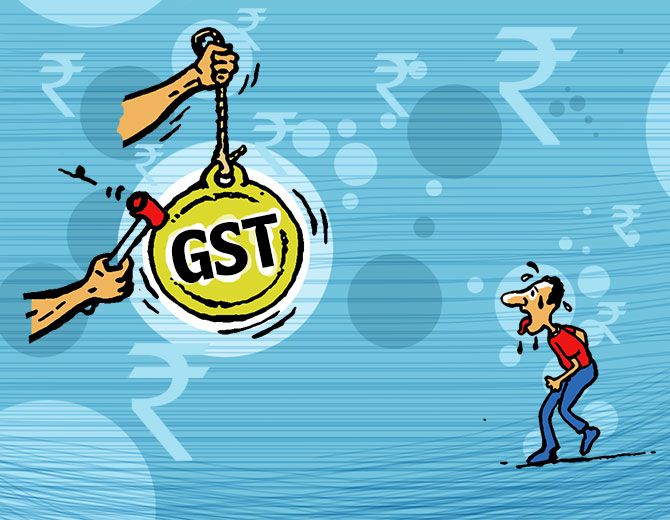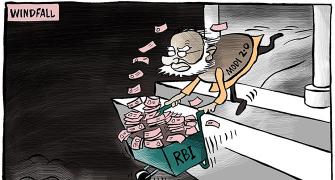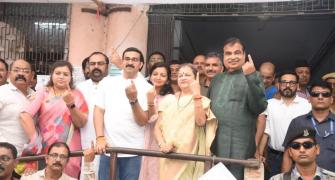The CAG audit and other data suggests it could be far from the efficient new alternative that was once conceptualised.
A conclusive review remains elusive till the government begins to release more granular and comparable data on the complex backend of GST to a deeper scrutiny, by researchers, auditors and the public.
Illustration: Dominic Xavier/Rediff.com

In July, the Comptroller and Auditor General (CAG) of India conducted its first ever audit of the Goods and Services (GST) tax regime, the implementation of which has been a signature initiative of the National Democratic Alliance, and pointed to many flaws that persist two years after GST’s nationwide rollout.
These were the headline findings that were widely reported.
A closer reading of the report reveals some startling and worrisome facts.
These findings, it should be noted, are from a partial audit exercise because in breach of constitutional provisions and legal obligations, CAG was not provided full access to the GST database.
With the Union government preventing a comprehensive audit, CAG carried out a test audit instead.
As the report points out, “Providing such data as CAG may require is a constitutional and legal requirement.”
CAG’s persistence got it aggregated statistics instead of full access to granular data. “…(The) audit, therefore, was hampered in the detailed analysis of pan–India transactions,” it says.
But even this limited exercise proved eye-opening.
“The gamut of issues brought out even in this limited audit point to serious systemic deficiencies that need to be addressed by the (revenue) department.”
Granular, comparable and regularly updated data on GST has never been shared by the government with researchers or the public.
This has made it difficult to review GST’s functioning beyond the headline gross monthly collections.
So far, reviewers have tried their best to draw a picture out of the Controller General of Accounts (CGA) figures, the government’s partial responses to Right to Information Act, answers in Parliament and the occasional discussions and data found in records of GST council meetings.
But these discrete packets of information do not permit a deeper analysis.
CAG’s test audit shows us why such granular information is vital.
The audit tells us that the state of GST is in much worse shape than what the government has suggested.
Take the example of one gross error CAG discovered in the sample data it was allowed to test.
Just one individual entity in Andhra Pradesh erroneously made a single entry in the GST online records for input credit worth Rs 6.45 trillion - amounting to 79 per cent of the input credit claimed across the country by all registered entities in one month (Rs 8.19 trillion).
This erroneous entry went undetected in the system till CAG pointed it out during the audit.
In fact, the auditors noted a trend of anomalies in the input credit generation.
It warned of consequences for not just overall revenue collected but also how the tax collected on inter-state transactions is shared with states.
The auditors concluded, “The system in vogue today is an unverified return, without an IT-based checking of invoices and is prone to ITC frauds.
"The self-correcting system, as originally envisaged, is not in place and this has led to continuation of avoidable assessee-tax officer physical interface instead of IT-based interface.
"Without invoice matching and auto generation of refunds, assessments etc on the whole, the envisaged GST tax compliance system is non-functional.”
One of the chief objectives of GST was to reduce evasion and fraud.
In 2018-19, GST Intelligence officials detected 1,620 cases worth Rs 11,251 crore of fraud.
In the absence of automated checks, officials had to depend on manual checks and analytics coupled with field investigations to unearth these frauds.
In July this year, they detected the case of an individual who had floated 90 fictitious companies, operated 173 different bank accounts on the GST database and created fictitious trade worth Rs 7,672 crore helping “established traders and cotton yarn spinners” to defraud the government of Rs 660 crore of revenue.
More than a 100 such cases of fraud had been detected by June this year.
The fundamental idea that distinguished GST from previous indirect tax regime was the use of 100 per cent voucher-to-voucher matching to avoid cascading tax-on-tax.
But with government putting this on hold, the tax system has become highly inefficient.
It led to leakage of tax as well as problems in revenue-sharing between states and Centre, the audit notes.
The audit found, without the automated matching of vouchers, the GST system is unable to generate all the reports required to correctly settle IGST into the states’ and Centre’s shares.
This led to Rs 1.77 trillion of IGST standing unsettled by the end of FY18.
Breaching the law, the Union government wrongly appropriated an extra Rs 57,450 crore of state’s share from this in FY18-19.
CAG found that the IGST settlement system continued to be flawed till as recently as May 2019.
Another reflection on how the GST regime continues to be hobbled is the CAG’s conclusion that, “While it was expected that compliance would improve as the system would stabilise, all returns being filed showed a declining trend of filing from April 2018 to December 2018.”
Introduction of GSTR-3B returns allowed unverified claims of input credit, which in turn led to reduced annual filings which would allow tax officials a degree of scrutiny.
The government plans to pilot-test and introduce yet another set of returns this year.
It is worth recalling that the previous indirect tax regimes were riddled with loopholes as well.
How better has the GST done and is it improving?
The CAG audit and other data suggests it could be far from the efficient new alternative that was once conceptualised.
The audit notes that the revenue for the Centre from indirect taxes on goods and services subsumed under GST fell by about 10 per cent in 2017-18 over previous year even after accounting for the excess apportionment of states’ share that year by the Centre.
But, a conclusive review remains elusive till the government begins to release more granular and comparable data on the complex backend of GST to a deeper scrutiny, by researchers, auditors and the public.










